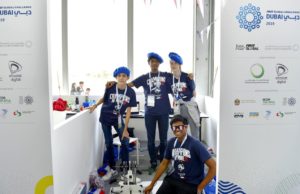Are Robots The Answer To Cleaning Our Oceans?
Among the buzz and chatter of the FIRST Global Challenge 2019 in Dubai, multiple blue, white and red flags decorate a small booth in the corner of the arena. As the only French team to have ever participated in the Challenge, four French students carry the weight of their nation’s expectations, and are deeply rivetted by the task of perfecting their robot.
Their mentor, Ronald Schildge, is a Computer Science teacher at the American School of Paris (ASP). Ahead of the historical visit to Dubai, he sent out an application asking his students to explain why they would like to participate in the Challenge and proceeded to pick the four best students. Due to the international student demographic and curriculum at the school, the team only managed to start working on their project in September, gathering two to three times a week to execute their idea.
As students interested in math and science, Pranav Sreedhar, Vignesh Sreedhar, Coline McEachern, and Aubin Guyon are always looking for ways to fix things. “The machines we create can make a difference in the world,” explains Pranav, 17, who also serves as the President of the Robotics Club at ASP. “Robotics holds a lot of solutions and can change multiple aspects of our lives,” intersperses Coline, who believes that robotics will be key to solving the issue of pollution.
Their current robot is the remake of their first effort that featured a linear slide and clamp. With a basket holding a replica of the Eiffel Tower, the new robot aims to collect the macro pollutants, represented by large, orange foam balls, from the playing field into the “recovery” level. This level represents an alternative environment where pollutants from the ocean are contained. Also featuring a catapult that can transfer pollutants to the “recycle” and “reuse” levels, the robot is undeniably a well thought-out creation.
Looking ahead, Team France predicts that many problems of the future will be resolved through leveraging innovation and AI. “I think that any solution we create will 100 percent involve engineering and robots,” says Coline. “One person can only do so much. Having robots to help us, will make some tasks faster and more efficient, especially when it comes to pollution.”
“There is a whole continent of trash in the ocean,” adds Coline.
In fact, the Ocean Conservancy, a nonprofit environmental advocacy group based in Washington, DC, estimates that humans add about eight million tons of plastic to the ocean every year, and a total of 150 million metric tons of plastics are circulating in the oceans right now. With our current situation, we are going to need all the help we can get to make some impact with cleaning this up.







